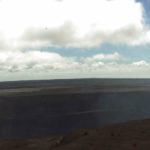Kīlauea volcano is not erupting, however its summit is currently exhibiting signs of elevated unrest. No unusual activity has been noted along Kīlauea’s East Rift Zone or Southwest Rift Zone.
During the past week, earthquake rates beneath the Kīlauea summit region have increased from an average of about 20 earthquakes per day to over 40 per day. Ground deformation rates are also high at the summit of Kīlauea, similar to conditions before the June 7, 2023, eruption.
The week’s earthquakes peaked at 100 on Sunday, August 13, including a magnitude-4.3 event that was felt across Hawaiʻi Island. Most other earthquakes were smaller than magnitude-2 and primarily occurred at 0–2 km depth beneath Kaluapele (Kīlauea caldera, including Halemaʻumaʻu) but also extended northeast towards Kīlauea Iki Crater and along the southern end of the caldera.
The recent increase in seismicity at the summit was accompanied by a brief increase in the rate of ground tilt, which has since returned to steady-state. Gas emissions remain low, reflective of the current lack in eruptive activity at the summit.
These observations indicate that magma is accumulating beneath the surface of Kīlauea’s summit region. The elevated unrest suggests that an eruption might be possible with little or no warning, but there is no sign that one is imminent.
The Hawaiian Volcano Observatory continues to monitor Kīlauea and other Hawaiian volcanoes for any changes.
Photo credit: HVO
